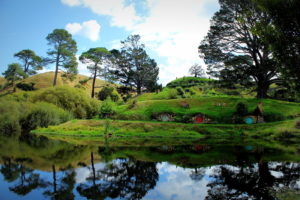
Hosted by Long and Short Reviews.
Click here to read everyone else’s replies to this week’s question and to read everyone else’s replies to this week’s question and here to see the full list of topics for the year.
I have two answers to this week’s question. The first is from a classic series and the second is from a modern one.
The Chronicles of Narnia
 When I was a kid, my uncle gave me his old, complete set of C.S. Lewis’ Chronicles of Narnia books, and I reread those stories over and over again for many years. Can I assume that a spoiler tag isn’t necessary for a more than 70-year-old series? Skip the next two paragraphs if you believe that this isn’t enough time yet to talk about how it ends. 😉
When I was a kid, my uncle gave me his old, complete set of C.S. Lewis’ Chronicles of Narnia books, and I reread those stories over and over again for many years. Can I assume that a spoiler tag isn’t necessary for a more than 70-year-old series? Skip the next two paragraphs if you believe that this isn’t enough time yet to talk about how it ends. 😉
One thing I strongly disliked about the plot was the way Susan was treated. All of the other main characters end up in the Narnian version of heaven in the end, even folks who made terrible choices earlier on. But Susan is left behind in our world to deal with the overwhelming grief of simultaneously losing her parents, siblings, and a few dear friends because she was growing up and becoming interested in parties and makeup instead of reminiscing about her childhood adventures.
That ending made me so angry when I was a kid. Of course she moved on to other interests as she grew older. Literally everyone does that, and most of us tend to do it multiple times throughout life. It’s completely normal. If certain other characters could betray everyone in their group and still be forgiven, she should have been forgiven for what I see as a much milder offence that could easily be chalked up to her being a teenager who was trying to figure out what adulthood might look like for her and who would have almost certainly circled back to Narnia once she was a little older.
C.S. Lewis should have written one final book to redeem Susan’s character arc and give her the happy ending she deserved. If one of you invents a time machine, I will volunteer to go back to the 1950s and talk him into it.
Monk & Robot Series
I’ve discussed this solarpunk series by Becky Chambers here in at least one previous Wednesday Weekly Blogging Challenge post, but let’s dive into it again.
A Psalm for the Wild-Built and A Prayer for the Crown-Shy are still the only two instalments of it. They follow a monk named Sibling Dex who lives in a utopian future called Panga where humanity lives in harmony with nature (and mostly with each other as well). People occupy some of the land, but the rest is left to grow into lush forests, marshes, or whatever other sorts of environments the local climate can support without any interference from humans.
 Sibling Dex breaks the rules of their society by venturing out into one of those dark, healthy, thick forests one day to see what they might find there.
Sibling Dex breaks the rules of their society by venturing out into one of those dark, healthy, thick forests one day to see what they might find there.
I won’t share any spoilers about what might be lurking out there since these novellas are only a few years old, but I will say that I adored the world-building and character development of them. They’re gentle but deep and so rewarding once you pause to think about all of the new details that slowly emerge about how nice it is to live in Panga.
We desperately need another instalment of Sibling Dex’s adventures in my opinion. There are still so many facets of this world that need to be explored. Honestly, I’m hoping there will be at least two or three more books to come without any time machines or persuasion needed, but even one would suffice!




 Example: The creepy Fire Swamp in William Goldman’s “The Princess Bride”
Example: The creepy Fire Swamp in William Goldman’s “The Princess Bride”









 The time: Early 1990s
The time: Early 1990s The time: Late 1990s
The time: Late 1990s The time: The late 2000s
The time: The late 2000s I spent four years of my childhood in Laramie, Wyoming, so C.S. Lewis’ descriptions of a world where it was always winter actually sounded kind of familiar to me.
I spent four years of my childhood in Laramie, Wyoming, so C.S. Lewis’ descriptions of a world where it was always winter actually sounded kind of familiar to me. From Eowyn Ivey’s
From Eowyn Ivey’s  The Mamutoi were the first band of humans that Ayla, a human girl who was raised by Neanderthals, had ever met.
The Mamutoi were the first band of humans that Ayla, a human girl who was raised by Neanderthals, had ever met.



